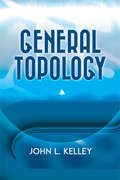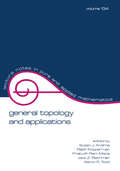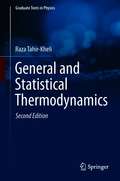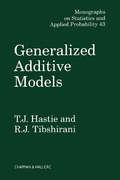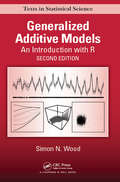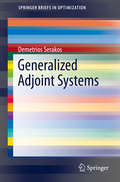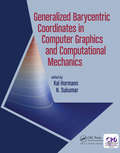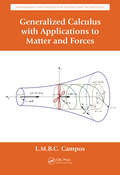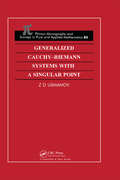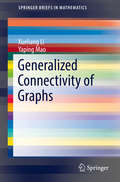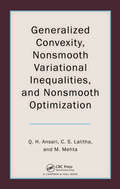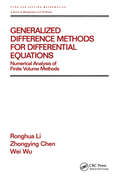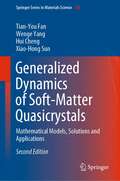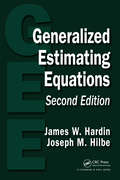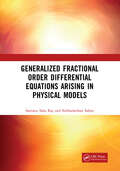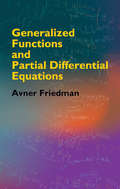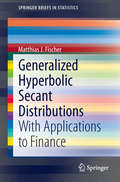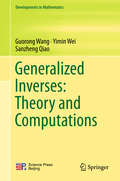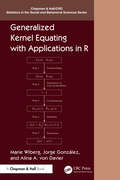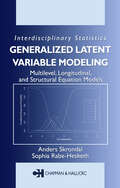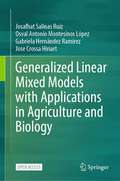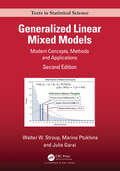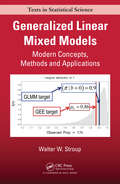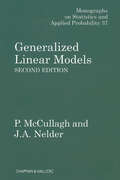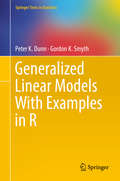- Table View
- List View
General Topology (Dover Books on Mathematics)
by John L. Kelley"The clarity of the author's thought and the carefulness of his exposition make reading this book a pleasure," noted the Bulletin of the American Mathematical Society upon the 1955 publication of John L. Kelley's General Topology. This comprehensive treatment for beginning graduate-level students immediately found a significant audience, and it remains a highly worthwhile and relevant book for students of topology and for professionals in many areas. A systematic exposition of the part of general topology that has proven useful in several branches of mathematics, this volume is especially intended as background for modern analysis. An extensive preliminary chapter presents mathematical foundations for the main text. Subsequent chapters explore topological spaces, the Moore-Smith convergence, product and quotient spaces, embedding and metrization, and compact, uniform, and function spaces. Each chapter concludes with an abundance of problems, which form integral parts of the discussion as well as reinforcements and counter examples that mark the boundaries of possible theorems. The book concludes with an extensive index that provides supplementary material on elementary set theory.
General Topology and Applications: Fifth Northeast Conference (Annals Of The New York Academy Of Sciences Ser. #Vol. 659)
by Susan J. AndimaThis book is based on the proceedings of the Fifth Northeast Conference on General Topology and Applications, held at The College of Staten Island – The City University of New York. It provides insight into the relationship between general topology and other areas of mathematics.
General and Statistical Thermodynamics (Graduate Texts in Physics)
by Raza Tahir-KheliThis textbook provides comprehensive information on general and statistical thermodynamics. It begins with an introductory statistical mechanics course, deriving all the important formulae meticulously and explicitly, without mathematical shortcuts. In turn, the main part of the book focuses on in-depth discussions of the concepts and laws of thermodynamics, van der Waals, Kelvin and Claudius theories, ideal and real gases, thermodynamic potentials, phonons and all related aspects. To elucidate the concepts introduced and to provide practical problem-solving support, numerous carefully worked-out examples are included. The text is clearly written and punctuated with a number of interesting anecdotes. The book also provides alternative solutions to problems and second equivalent explanations of important physical concepts. This second edition has been expanded to cover the foundations of superconductivity with new chapters on Cooper pairs, the Bogoliubov transformation, and superconductivity. It is suitable as a main thermodynamics textbook for upper-undergraduate students and provides extensive coverage, allowing instructors to ‘pick and choose’ the elements that best match their class profile.
Generalized Additive Models
by T.J. HastieThis book describes an array of power tools for data analysis that are based on nonparametric regression and smoothing techniques. These methods relax the linear assumption of many standard models and allow analysts to uncover structure in the data that might otherwise have been missed. While McCullagh and Nelder's Generalized Linear Models shows how to extend the usual linear methodology to cover analysis of a range of data types, Generalized Additive Models enhances this methodology even further by incorporating the flexibility of nonparametric regression. Clear prose, exercises in each chapter, and case studies enhance this popular text.
Generalized Additive Models: An Introduction with R, Second Edition (Chapman & Hall/CRC Texts in Statistical Science)
by Simon N. WoodThe first edition of this book has established itself as one of the leading references on generalized additive models (GAMs), and the only book on the topic to be introductory in nature with a wealth of practical examples and software implementation. It is self-contained, providing the necessary background in linear models, linear mixed models, and generalized linear models (GLMs), before presenting a balanced treatment of the theory and applications of GAMs and related models. The author bases his approach on a framework of penalized regression splines, and while firmly focused on the practical aspects of GAMs, discussions include fairly full explanations of the theory underlying the methods. Use of R software helps explain the theory and illustrates the practical application of the methodology. Each chapter contains an extensive set of exercises, with solutions in an appendix or in the book’s R data package gamair, to enable use as a course text or for self-study.
Generalized Adjoint Systems
by Demetrios SerakosThis book defines and develops the generalized adjoint of an input-output system. It is the result of a theoretical development and examination of the generalized adjoint concept and the conditions under which systems analysis using adjoints is valid. Results developed in this book are useful aids for the analysis and modeling of physical systems, including the development of guidance and control algorithms and in developing simulations. The generalized adjoint system is defined and is patterned similarly to adjoints of bounded linear transformations. Next the elementary properties of the generalized adjoint system are derived. For a space of input-output systems, a generalized adjoint map from this space of systems to the space of generalized adjoints is defined. Then properties of the generalized adjoint map are derived. Afterward the author demonstrates that the inverse of an input-output system may be represented in terms of the generalized adjoint. The use of generalized adjoints to determine bounds for undesired inputs such as noise and disturbance to an input-output system is presented and methods which parallel adjoints in linear systems theory are utilized. Finally, an illustrative example is presented which utilizes an integral operator representation for the system mapping.
Generalized Barycentric Coordinates in Computer Graphics and Computational Mechanics
by N. Sukumar Kai HormannIn Generalized Barycentric Coordinates in Computer Graphics and Computational Mechanics, eminent computer graphics and computational mechanics researchers provide a state-of-the-art overview of generalized barycentric coordinates. Commonly used in cutting-edge applications such as mesh parametrization, image warping, mesh deformation, and finite as well as boundary element methods, the theory of barycentric coordinates is also fundamental for use in animation and in simulating the deformation of solid continua. Generalized Barycentric Coordinates is divided into three sections, with five chapters each, covering the theoretical background, as well as their use in computer graphics and computational mechanics. A vivid 16-page insert helps illustrating the stunning applications of this fascinating research area. <P><P>Key Features: <li>Provides an overview of the many different types of barycentric coordinates and their properties. <li>Discusses diverse applications of barycentric coordinates in computer graphics and computational mechanics. <li>The first book-length treatment on this topic
Generalized Calculus with Applications to Matter and Forces (Mathematics and Physics for Science and Technology)
by Luis Manuel Braga de Costa CamposCombining mathematical theory, physical principles, and engineering problems, Generalized Calculus with Applications to Matter and Forces examines generalized functions, including the Heaviside unit jump and the Dirac unit impulse and its derivatives of all orders, in one and several dimensions. The text introduces the two main approaches to genera
Generalized Cauchy-Riemann Systems with a Singular Point
by Zafar D UsmanovA theory of generalized Cauchy-Riemann systems with polar singularities of order not less than one is presented and its application to study of infinitesimal bending of surfaces having positive curvature and an isolated flat point is given. The book contains results of investigations obtained by the author and his collaborators.
Generalized Connectivity of Graphs
by Xueliang Li Yaping MaoNoteworthy results, proof techniques, open problems and conjectures in generalized (edge-) connectivity are discussed in this book. Both theoretical and practical analyses for generalized (edge-) connectivity of graphs are provided. Topics covered in this book include: generalized (edge-) connectivity of graph classes, algorithms, computational complexity, sharp bounds, Nordhaus-Gaddum-type results, maximum generalized local connectivity, extremal problems, random graphs, multigraphs, relations with the Steiner tree packing problem and generalizations of connectivity. This book enables graduate students to understand and master a segment of graph theory and combinatorial optimization. Researchers in graph theory, combinatorics, combinatorial optimization, probability, computer science, discrete algorithms, complexity analysis, network design, and the information transferring models will find this book useful in their studies.
Generalized Convexity, Nonsmooth Variational Inequalities, and Nonsmooth Optimization
by Qamrul Hasan Ansari C. S. Lalitha Monika MehtaUntil now, no book addressed convexity, monotonicity, and variational inequalities together. Generalized Convexity, Nonsmooth Variational Inequalities, and Nonsmooth Optimization covers all three topics, including new variational inequality problems defined by a bifunction.The first part of the book focuses on generalized convexity and generalized
Generalized Difference Methods for Differential Equations: Numerical Analysis of Finite Volume Methods (Chapman & Hall/CRC Pure and Applied Mathematics)
by Ronghua Li Zhongying Chen Wei WuThis text presents a comprehensive mathematical theory for elliptic, parabolic, and hyperbolic differential equations. It compares finite element and finite difference methods and illustrates applications of generalized difference methods to elastic bodies, electromagnetic fields, underground water pollution, and coupled sound-heat flows.
Generalized Dynamics of Soft-Matter Quasicrystals: Mathematical Models, Solutions and Applications (Springer Series in Materials Science #260)
by Tian-You Fan Wenge Yang Hui Cheng Xiao-Hong SunThis book highlights the mathematical models and solutions of the generalized dynamics of soft-matter quasicrystals (SMQ) and introduces possible applications of the theory and methods. Based on the theory of quasiperiodic symmetry and symmetry breaking, the book treats the dynamics of individual quasicrystal systems by reducing them to nonlinear partial differential equations and then provides methods for solving the initial-boundary value problems in these equations. The solutions obtained demonstrate the distribution, deformation and motion of SMQ and determine the stress, velocity and displacement fields. The interactions between phonons, phasons and fluid phonons are discussed in some fundamental materials samples. The reader benefits from a detailed comparison of the mathematical solutions for both solid and soft-matter quasicrystals, gaining a deeper understanding of the universal properties of SMQ. The second edition covers the latest research progress on quasicrystals in topics such as thermodynamic stability, three-dimensional problems and solutions, rupture theory, and the photonic band-gap and its applications. These novel chapters make the book an even more useful and comprehensive reference guide for researchers in condensed matter physics, chemistry and materials sciences.
Generalized Estimating Equations
by Joseph M. Hilbe James W. HardinGeneralized Estimating Equations, Second Edition updates the best-selling previous edition, which has been the standard text on the subject since it was published a decade ago. Combining theory and application, the text provides readers with a comprehensive discussion of GEE and related models. Numerous examples are employed throughout the text, al
Generalized Fractional Order Differential Equations Arising in Physical Models
by Subhadarshan Sahoo Santanu RayThis book analyzes the various semi-analytical and analytical methods for finding approximate and exact solutions of fractional order partial differential equations. It explores approximate and exact solutions obtained by various analytical methods for fractional order partial differential equations arising in physical models.
Generalized Functions and Partial Differential Equations (Dover Books on Mathematics)
by Avner FriedmanThis self-contained treatment develops the theory of generalized functions and the theory of distributions, and it systematically applies them to solving a variety of problems in partial differential equations. A major portion of the text is based on material included in the books of L. Schwartz, who developed the theory of distributions, and in the books of Gelfand and Shilov, who deal with generalized functions of any class and their use in solving the Cauchy problem. In addition, the author provides applications developed through his own research.Geared toward upper-level undergraduates and graduate students, the text assumes a sound knowledge of both real and complex variables. Familiarity with the basic theory of functional analysis, especially normed spaces, is helpful but not necessary. An introductory chapter features helpful background on topological spaces. Applications to partial differential equations include a treatment of the Cauchy problem, the Goursat problem, fundamental solutions, existence and differentiality of solutions of equations with constants, coefficients, and related topics. Supplementary materials include end-of-chapter problems, bibliographical remarks, and a bibliography.
Generalized Hyperbolic Secant Distributions
by Matthias J. FischerAmong the symmetrical distributions with an infinite domain, the most popular alternative to the normal variant is the logistic distribution as well as the Laplace or the double exponential distribution, which was first introduced in 1774. Occasionally, the Cauchy distribution is also used. Surprisingly, the hyperbolic secant distribution has led a charmed life, although Manoukian and Nadeau had already stated in 1988 that ". . . the hyperbolic-secant distribution . . . has not received sufficient attention in the published literature and may be useful for students and practitioners. " During the last few years, however, several generalizations of the hyperbolic secant distribution have become popular in the context of financial return data because of its excellent fit. Nearly all of them are summarized within this Springer Brief.
Generalized Inverses: Theory and Computations (Developments in Mathematics #53)
by Yimin Wei Guorong Wang Sanzheng QiaoThis book begins with the fundamentals of the generalized inverses, then moves to more advanced topics.It presents a theoretical study of the generalization of Cramer's rule, determinant representations of the generalized inverses, reverse order law of the generalized inverses of a matrix product, structures of the generalized inverses of structured matrices, parallel computation of the generalized inverses, perturbation analysis of the generalized inverses, an algorithmic study of the computational methods for the full-rank factorization of a generalized inverse, generalized singular value decomposition, imbedding method, finite method, generalized inverses of polynomial matrices, and generalized inverses of linear operators. This book is intended for researchers, postdocs, and graduate students in the area of the generalized inverses with an undergraduate-level understanding of linear algebra.
Generalized Kernel Equating with Applications in R (Chapman & Hall/CRC Statistics in the Social and Behavioral Sciences)
by Jorge Gonzalez Marie Wiberg Alina A. von DavierGeneralized Kernel Equating is a comprehensive guide for statisticians, psychometricians, and educational researchers aiming to master test score equating. This book introduces the Generalized Kernel Equating (GKE) framework, providing the necessary tools and methodologies for accurate and fair score comparisons.The book presents test score equating as a statistical problem and covers all commonly used data collection designs. It details the five steps of the GKE framework: presmoothing, estimating score probabilities, continuization, equating transformation, and evaluating the equating transformation. Various presmoothing strategies are explored, including log-linear models, item response theory models, beta4 models, and discrete kernel estimators. The estimation of score probabilities when using IRT models is described and Gaussian kernel continuization is extended to other kernels such as uniform, logistic, epanechnikov and adaptive kernels. Several bandwidth selection methods are described. The kernel equating transformation and variants of it are defined, and both equating-specific and statistical measures for evaluating equating transformations are included. Real data examples, guiding readers through the GKE steps with detailed R code and explanations are provided. Readers are equipped with an advanced knowledge and practical skills for implementing test score equating methods.
Generalized Latent Variable Modeling: Multilevel, Longitudinal, and Structural Equation Models (Chapman & Hall/CRC Interdisciplinary Statistics)
by Anders Skrondal Sophia Rabe-HeskethThis book unifies and extends latent variable models, including multilevel or generalized linear mixed models, longitudinal or panel models, item response or factor models, latent class or finite mixture models, and structural equation models. Following a gentle introduction to latent variable modeling, the authors clearly explain and contrast a wi
Generalized Linear Mixed Models with Applications in Agriculture and Biology
by Osval Antonio Montesinos López Josafhat Salinas Ruíz Gabriela Hernández Ramírez Jose Crossa HiriartThis open access book offers an introduction to mixed generalized linear models with applications to the biological sciences, basically approached from an applications perspective, without neglecting the rigor of the theory. For this reason, the theory that supports each of the studied methods is addressed and later - through examples - its application is illustrated. In addition, some of the assumptions and shortcomings of linear statistical models in general are also discussed. An alternative to analyse non-normal distributed response variables is the use of generalized linear models (GLM) to describe the response data with an exponential family distribution that perfectly fits the real response. Extending this idea to models with random effects allows the use of Generalized Linear Mixed Models (GLMMs). The use of these complex models was not computationally feasible until the recent past, when computational advances and improvements to statistical analysis programs allowed users to easily, quickly, and accurately apply GLMM to data sets. GLMMs have attracted considerable attention in recent years. The word "Generalized" refers to non-normal distributions for the response variable and the word "Mixed" refers to random effects, in addition to the fixed effects typical of analysis of variance (or regression). With the development of modern statistical packages such as Statistical Analysis System (SAS), R, ASReml, among others, a wide variety of statistical analyzes are available to a wider audience. However, to be able to handle and master more sophisticated models requires proper training and great responsibility on the part of the practitioner to understand how these advanced tools work. GMLM is an analysis methodology used in agriculture and biology that can accommodate complex correlation structures and types of response variables.
Generalized Linear Mixed Models: Modern Concepts, Methods and Applications (Chapman & Hall/CRC Texts in Statistical Science)
by Walter W. Stroup Marina Ptukhina Julie GaraiGeneralized Linear Mixed Models: Modern Concepts, Methods, and Applications (2nd edition) presents an updated introduction to linear modeling using the generalized linear mixed model (GLMM) as the overarching conceptual framework. For students new to statistical modeling, this book helps them see the big picture – linear modeling as broadly understood and its intimate connection with statistical design and mathematical statistics. For readers experienced in statistical practice, but new to GLMMs, the book provides a comprehensive introduction to GLMM methodology and its underlying theory.Unlike textbooks that focus on classical linear models or generalized linear models or mixed models, this book covers all of the above as members of a unified GLMM family of linear models. In addition to essential theory and methodology, this book features a rich collection of examples using SAS® software to illustrate GLMM practice. This second edition is updated to reflect lessons learned and experience gained regarding best practices and modeling choices faced by GLMM practitioners. New to this edition are two chapters focusing on Bayesian methods for GLMMs.Key Features:• Most statistical modeling books cover classical linear models or advanced generalized and mixed models; this book covers all members of the GLMM family – classical and advanced models.• Incorporates lessons learned from experience and on-going research to provide up-to-date examples of best practices.• Illustrates connections between statistical design and modeling: guidelines for translating study design into appropriate model and in-depth illustrations of how to implement these guidelines; use of GLMM methods to improve planning and design.• Discusses the difference between marginal and conditional models, differences in the inference space they are intended to address and when each type of model is appropriate.• In addition to likelihood-based frequentist estimation and inference, provides a brief introduction to Bayesian methods for GLMMs.Walt Stroup is an Emeritus Professor of Statistics. He served on the University of Nebraska statistics faculty for over 40 years, specializing in statistical modeling and statistical design. He is a Fellow of the American Statistical Association, winner of the University of Nebraska Outstanding Teaching and Innovative Curriculum Award and author or co-author of three books on mixed models and their extensions.Marina Ptukhina (Pa-too-he-nuh), PhD, is an Associate Professor of Statistics at Whitman College. She is interested in statistical modeling, design and analysis of research studies and their applications. Her research includes applications of statistics to economics, biostatistics and statistical education. Ptukhina earned a PhD in Statistics from the University of Nebraska-Lincoln, a Master of Science degree in Mathematics from Texas Tech University and a Specialist degree in Management from The National Technical University "Kharkiv Polytechnic Institute."Julie Garai, PhD, is a Data Scientist at Loop. She earned her PhD in Statistics from the University of Nebraska-Lincoln and a bachelor’s degree in Mathematics and Spanish from Doane College. Dr Garai actively collaborates with statisticians, psychologists, ecologists, forest scientists, software engineers, and business leaders in academia and industry. In her spare time, she enjoys leisurely walks with her dogs, dance parties with her children, and playing the trombone.
Generalized Linear Mixed Models: Modern Concepts, Methods and Applications (Chapman & Hall/CRC Texts in Statistical Science)
by Walter W. StroupWith numerous examples using SAS PROC GLIMMIX, this text presents an introduction to linear modeling using the generalized linear mixed model as an overarching conceptual framework. For readers new to linear models, the book helps them see the big picture. It shows how linear models fit with the rest of the core statistics curriculum and points out the major issues that statistical modelers must consider.
Generalized Linear Models (Chapman & Hall/CRC Monographs on Statistics and Applied Probability #37)
by P. McCullaghThe success of the first edition of Generalized Linear Models led to the updated Second Edition, which continues to provide a definitive unified, treatment of methods for the analysis of diverse types of data. Today, it remains popular for its clarity, richness of content and direct relevance to agricultural, biological, health, engineering, and ot
Generalized Linear Models With Examples in R (Springer Texts in Statistics)
by Peter K. Dunn Gordon K. SmythThis textbook presents an introduction to multiple linear regression, providing real-world data sets and practice problems. A practical working knowledge of applied statistical practice is developed through the use of these data sets and numerous case studies. The authors include a set of practice problems both at the end of each chapter and at the end of the book. Each example in the text is cross-referenced with the relevant data set, so that readers can load the data and follow the analysis in their own R sessions. The balance between theory and practice is evident in the list of problems, which vary in difficulty and purpose.This book is designed with teaching and learning in mind, featuring chapter introductions and summaries, exercises, short answers, and simple, clear examples. Focusing on the connections between generalized linear models (GLMs) and linear regression, the book also references advanced topics and tools that have not typically been included in introductions to GLMs to date, such as Tweedie family distributions with power variance functions, saddlepoint approximations, likelihood score tests, modified profile likelihood, and randomized quantile residuals. In addition, the authors introduce the new R code package, GLMsData, created specifically for this book. Generalized Linear Models with Examples in R balances theory with practice, making it ideal for both introductory and graduate-level students who have a basic knowledge of matrix algebra, calculus, and statistics.
